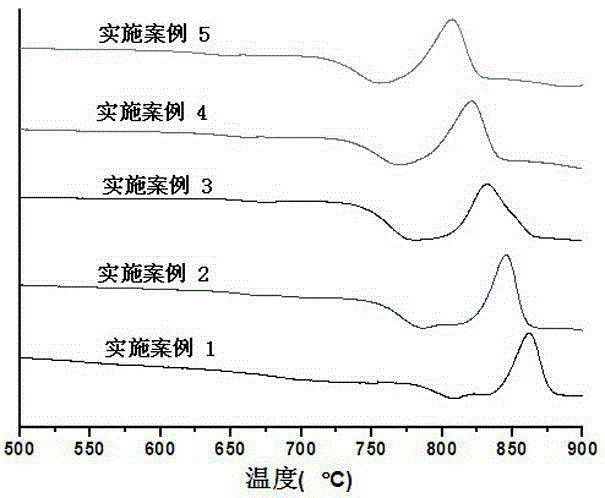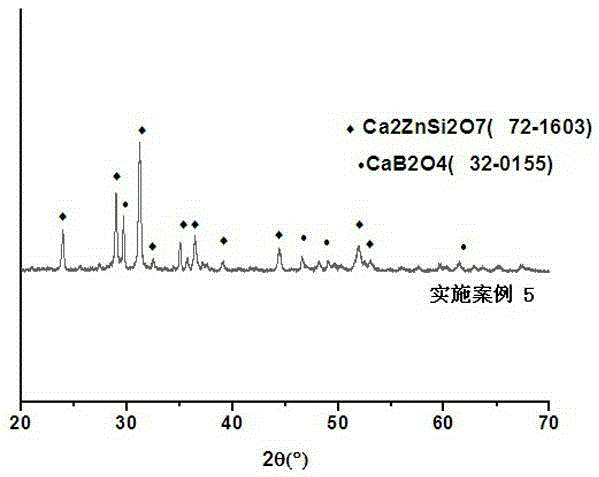A kind of ZNO-containing sealing glass-ceramics and its preparation and use method
A technology of glass-ceramics and glass sealing, which is applied in the field of solid oxide fuel cells, can solve the problems of reducing the thermal stability of glass, the attenuation of cathode catalytic performance, and affecting the airtightness of sealing materials, etc., achieving low cost and simple preparation of raw materials , the effect of process stability
- Summary
- Abstract
- Description
- Claims
- Application Information
AI Technical Summary
Problems solved by technology
Method used
Image
Examples
Embodiment 1
[0030] Embodiment 1: Preparation and sealing of materials
[0031] According to the ratio of each component in Table 1, weigh a certain amount of analytically pure raw materials (CaO, SrO, SiO 2 、Al 2 o 3 , B 2 o 3 , ZnO), and mix them evenly with a planetary ball mill for 24 hours; then put the powder into a platinum crucible, place it in the air atmosphere of a box-type resistance furnace, heat it to 1350°C at 3°C / min, and keep it for 1 hour; then, take it out Crucible, the melt is poured into deionized water for rapid cooling, and dried to obtain fragments of the glass melt; ground and passed through a 100-mesh sieve to obtain glass powder. Mix glass powder with polyvinyl alcohol, fish oil, ethanol and toluene (80%, 2%, 1%, 10%, 7% by weight) to form a slurry, and disperse evenly in a ball mill; tape casting, natural Dry, then cut into the embryo body of the desired shape; place the embryo body on the part to be sealed, heat up in an electric furnace at a rate of 2°C / m...
Embodiment 2
[0032] Embodiment 2: Preparation and sealing of materials
[0033] According to the ratio of each component in Table 1, weigh a certain amount of analytically pure raw materials (CaO, SrO, SiO 2 、Al 2 o 3 , B 2 o 3 , ZnO), and mix them evenly with a planetary ball mill for 24 hours; then put the powder into a platinum crucible, place it in the air atmosphere of a box-type resistance furnace, heat it to 1340°C at 3°C / min, and keep it warm for 1 hour; then, take it out Crucible, the melt is poured into deionized water for rapid cooling, and dried to obtain fragments of the glass melt; ground and passed through a 100-mesh sieve to obtain glass powder. Mix glass powder with methylcellulose, polyvinyl alcohol, n-butanol and acetone (82%, 2%, 2%, 8%, 6% by weight) to form a slurry, and disperse evenly in a ball mill; Stretching, drying naturally, and then cutting the embryo body into the desired shape; placing the embryo body on the part to be sealed, raising the temperature in...
Embodiment 3
[0034] Embodiment 3: Preparation and sealing of materials
[0035] According to the ratio of each component in Table 1, weigh a certain amount of analytically pure raw materials (CaO, SrO, SiO 2 、Al 2 o 3 , B 2 o 3 , ZnO), and mixed evenly with a planetary ball mill for 24 hours; then put the powder into a platinum crucible, place it in the air atmosphere of a box-type resistance furnace, heat it to 1325°C at 3°C / min, and keep it for 1 hour; then, take it out Crucible, the melt is poured into deionized water for rapid cooling, and dried to obtain fragments of the glass melt; ground and passed through a 100-mesh sieve to obtain glass powder. Mix glass powder with epoxy resin, polyacrylamide, isopropanol and toluene (84%, 1.5%, 0.5%, 9%, 5% by weight) to form a slurry, and disperse evenly in a ball mill; casting Forming, drying naturally, and then cutting into the embryo body of the desired shape; place the embryo body at the part to be sealed, heat up at a rate of 2°C / min ...
PUM
| Property | Measurement | Unit |
|---|---|---|
| glass transition temperature | aaaaa | aaaaa |
| crystallization temperature | aaaaa | aaaaa |
| transition temperature | aaaaa | aaaaa |
Abstract
Description
Claims
Application Information
 Login to View More
Login to View More - R&D
- Intellectual Property
- Life Sciences
- Materials
- Tech Scout
- Unparalleled Data Quality
- Higher Quality Content
- 60% Fewer Hallucinations
Browse by: Latest US Patents, China's latest patents, Technical Efficacy Thesaurus, Application Domain, Technology Topic, Popular Technical Reports.
© 2025 PatSnap. All rights reserved.Legal|Privacy policy|Modern Slavery Act Transparency Statement|Sitemap|About US| Contact US: help@patsnap.com



